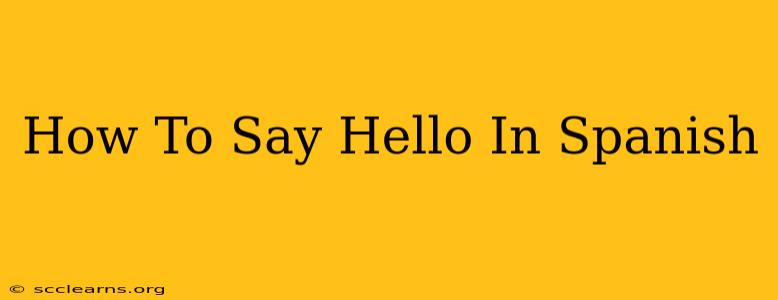Learning a new language can be exciting, and Spanish is a particularly rewarding one to learn, given its widespread use across the globe. One of the first things you'll want to know is how to greet people. This guide will explore various ways to say "hello" in Spanish, covering different levels of formality and regional variations.
Basic Greetings: Hola and Buenos Días/Tardes/Noches
The most common way to say hello in Spanish is "Hola". This is a versatile greeting suitable for almost any situation, informal or formal. Think of it as the Spanish equivalent of "Hi" or "Hello".
However, Spanish also offers more nuanced greetings depending on the time of day:
- Buenos días: Good morning. Use this from sunrise until noon.
- Buenas tardes: Good afternoon/good evening. Use this from noon until sunset.
- Buenas noches: Good night/good evening. Use this from sunset onwards.
These greetings are considered more polite and formal than simply saying "Hola," especially in professional settings or when meeting someone for the first time.
Beyond "Hola": More Ways to Greet Someone in Spanish
While "Hola" is perfectly acceptable in most situations, there are other ways to greet someone in Spanish, adding a touch of personality or formality to your interactions.
Informal Greetings:
- ¿Qué tal?: How's it going? This is an informal way to ask "how are you?" and is suitable for friends and acquaintances.
- ¿Qué pasa?: What's up? Similar to "¿Qué tal?", this is very informal.
- ¿Cómo estás?: How are you? This is a more formal way of asking "how are you?", but still appropriate for friends and family.
Formal Greetings:
- ¿Cómo está?: How are you? This is the formal version of "¿Cómo estás?". Use this when speaking to elders, superiors, or people you don't know well.
- Mucho gusto: Pleased to meet you. This is used when meeting someone for the first time.
- Encantado/Encantada: Delighted/Pleased to meet you. "Encantado" is used by men, and "Encantada" by women.
Regional Variations
While the greetings mentioned above are widely understood throughout the Spanish-speaking world, there can be slight regional variations. For example, in some regions of Spain, you might hear greetings like:
- ¿Qué hay?: What's up? (Very informal)
- ¿Qué onda?: What's up? (Very informal, more common in Mexico)
Mastering Spanish Greetings: Practice Makes Perfect!
The best way to learn how to say hello in Spanish (and other phrases) is through practice. Try using these greetings in conversations, and don't be afraid to experiment. The more you use them, the more natural they will become. Immerse yourself in the language through movies, music, and conversations with native speakers, and you'll quickly improve your fluency.
Key Takeaways
- Hola: The most basic and versatile way to say hello.
- Buenos días/tardes/noches: More formal greetings based on the time of day.
- Context is key: Choose your greeting based on the level of formality and your relationship with the person you are addressing.
- Practice regularly: The best way to improve your Spanish is to use it!
By incorporating these greetings into your daily practice, you'll be well on your way to confidently navigating conversations in Spanish and making a positive impression on those you meet. ¡Buena suerte! (Good luck!)

